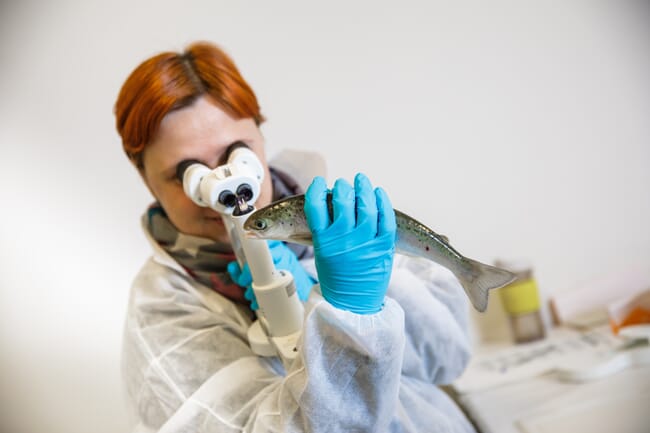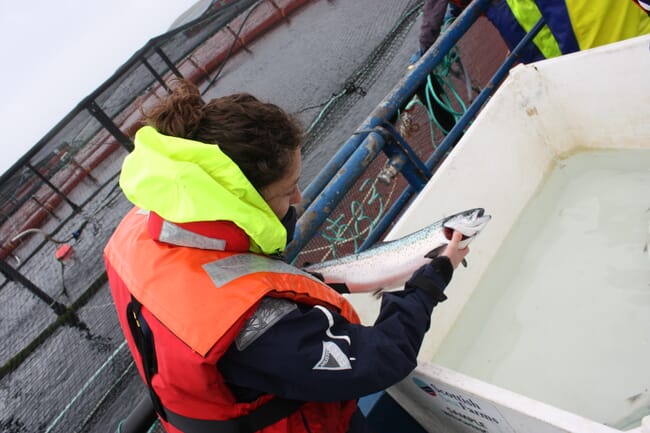The free 351-page document, Welfare indicators for farmed Atlantic salmon – tools for assessing fish welfare, is the result of the FISHWELL project, which looks at how to assess the welfare of farmed salmon in different production systems and husbandry practices.

© FISHWELL
“The project was initiated by the FHF in response to needs reported from the industry to collate the available knowledge on fish welfare in Atlantic salmon, and develop a uniform and applicable framework for operational welfare indicators and welfare assessments,” explains Sven Martin Jørgensen, R&D director at the Norwegian Seafood Research Fund (FHF), which funded the project.
“The project goals are to provide the industry and other interested stakeholders with a handbook on the correct fit-for-purpose welfare indicators for assessing salmon welfare across different rearing systems, routines and operations, based upon sound science,” adds Nofima's Chris Noble, the project lead.
In creating the handbook, which was originally published in Norwegian last year, Nofima collaborated with the Institute of Marine Research (IMR), the Norwegian Veterinary Institute (NVI), Nord University in Bodø and the University of Stirling.
Welfare indicators
The partners drew up a number of welfare indicators based upon the animal or its rearing environment, and examples of these include appetite, the fishes’ behaviour, physiological status, gill condition, fin damage, skeletal status, temperature and water flow rate. Those which are suitable for aquaculture are called operational welfare indicators (OWIs) or laboratory welfare indicators (LABWIs).
“For a welfare indicator to be deemed as operational (an OWI) it must truly say something about the welfare of the fish but still be simple to use out on the farm. If a sample must be sent to a lab for analysis we define it as a laboratory-based welfare indicator (LABWI),” says IMR’s Jonatan Nilsson.
“We initially evaluated over 90 welfare indicators and we ended up identifying approximately 50 as OWIs/LABWIs. So a lot of work involved going through all the documentation and publications regarding the suite of different welfare indicators that we have at the moment. And the reader should bear in mind that new welfare indicators are being developed all the time,” adds Martin Iversen from Nord University.
The focus on OWIs and LABWIs is what makes the publication so unique.
“This helps the farmers decide which welfare indicators are best suited for different rearing systems and operations. It is not a welfare standard or anything like that, it is aimed at helping the farmers or other interested stakeholders use the correct OWIs for assessing welfare in different situations and provides the scientific justification for this,” Noble reflects.

Three-part manual
“The handbook is split into three parts: part A provides the most up-to-date scientific research into the welfare of Atlantic salmon, in relation to its welfare needs at different life stages; Part B is a user guide on fit-for-purpose OWIs and LABWIs for assessing fish welfare in different rearing and production systems; and Part C outlines fit-for-purpose OWIs and LABWIs for assessing fish welfare in different routines and handling practices,” Noble explains.
The handbook caters for all levels of experience and expertise.
“Both newcomers and seasoned staff can use it, seasoned staff probably use a lot of these indicators already to be honest. Still, it may help people refresh their knowledge using the latest findings from R&D,” says Noble.
“It can also raise awareness and stimulate knowledge transfer between staff with different levels of experience. The toolbox can be especially important for assessing welfare related to the use of new technologies which folk don’t have much experience with. It provides a ‘recipe’ on the need and process of welfare documentation on new technologies, and it tries to put all the info they need in one place,” adds Kristine Gismervik from the Norwegian Veterinary Institute:
The need for the publication is clear, not least given that mortality levels of salmon at sea are rising in many regions, and the authors hope to help to reverse this trend.
“One of the main reasons contributing to the rise in mortality is that many of the new environmental friendly delousing methods are stressful to the fish and put them at risk of physical injury. We know that fish with high welfare status have significant improved chance of surviving delousing operations, and that some delousing methods are more risky to the fish than others,” says IMR’s Lars H Stien.
“In addition, using fit-for-purpose welfare indicators to improve risk assessments, especially with regard to new technologies, may increase knowledge and awareness on how to avoid mortality and improve welfare. For example, with regard to delicing, better risk assessments can help the farmers decide which delousing method to use, and also when judging the effect of the treatment on the fish,” continues Gismervik.
The initiative, which was originally published in Norwegian in 2017, has attracted positive feedback from within the industry.
“The response has been entirely positive and several producers have already used the handbook as a basis for implementing operational welfare assessments in different production stages and routines,” says Jørgensen.
And operators outside the industry, such as certification scheme providers and retailers, have engaged with the project too.
“We have had some retailers and buyers contact us regarding the toolbox, and have had feedback that they have used it to help direct the questions they ask the producers. We have had some very good dialogue with the RSPCA throughout the project and have utilised some of their findings and recommendations in the FISHWELL handbook, especially with regard to procedures such as transport. Other certification schemes have also contacted us regarding how best to utilise the outputs of the handbook and also to discuss how to adapt the approach to other species,” says Noble.

Diversification and development
Although very much focused on salmon, could the structure of the handbook be adapted for the production of other species?
“It would be quite easy to adapt the approach for other species. The approach utilised in Part A, where we address the concept of welfare and the rationale for the choices of welfare needs and indicators, would be the same regardless of species. So adapting it for another species would mainly be to update tolerance and preference levels, see if there are any additional species specific welfare indicators that are applicable and to focus on farming techniques and operations that are relevant for that species,” says IMR's Nilsson.
Kolarevic also backs this up, saying: “The FISHWELL handbook is a good starting point for assembling an OWI/LABWI toolbox for other species. The FISHWELL team are currently adapting the salmon toolbox to make a sister handbook on rainbow trout. Some of the FISHWELL authors are also working on another project that will briefly summarise the R&D that has been done so far on OWIs and LABWIs for cleaner fish.”
FISHWELL will be drawing to a close next year, when a new handbook on rainbow trout is due to be published in both Norwegian and English, but the project’s participants then hope to build on its success.
“The project has brought together a lot of institutions working with fish welfare in Norway, creating a common platform for future projects,” says Noble.
“Although it has been a lot of work, we all agree that it has been worth it – we have enjoyed the discussions and want to build on this work in the near future,” Stien agrees.
To download the FISHWELL manual, click here.



